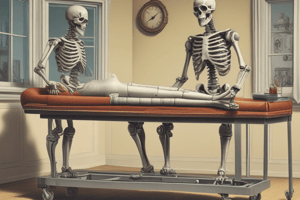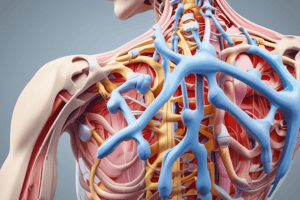Podcast
Questions and Answers
A patient presents with clicking and apprehension during the Anterior Drawer test. What condition is MOST likely indicated?
A patient presents with clicking and apprehension during the Anterior Drawer test. What condition is MOST likely indicated?
- Anterior GH joint instability or labral tear (correct)
- Posterior GH instability
- Gross instability of GH/dislocation
- Inferior GH instability
During the Apprehension Crank test, a patient exhibits muscle spasm and pain. What specific action during the test is MOST responsible for eliciting these symptoms if there is gross instability?
During the Apprehension Crank test, a patient exhibits muscle spasm and pain. What specific action during the test is MOST responsible for eliciting these symptoms if there is gross instability?
- Abducting the arm to 90 degrees
- Applying over pressure in full external rotation (correct)
- Stabilizing the scapula on the posterior aspect
- Applying a posterior force to the humerus
A physical therapist performs the Posterior Drawer test on a patient. Which combination of movements BEST isolates the posterior instability of the GH joint?
A physical therapist performs the Posterior Drawer test on a patient. Which combination of movements BEST isolates the posterior instability of the GH joint?
- Abduction to 80-120 degrees, flexion to 20-30 degrees, medial rotation, forward flexion to 60-80, and posterior force to the humerus. (correct)
- Observation with inferior humeral pull.
- Abduction to 90 degrees, forward flexion to 20 degrees, lateral rotation to 30 degrees, and anterior force to the humerus.
- Abduction to 90 degrees, forward flexion to 30 degrees, humeral head pushing down and elbow pulling up.
The Push-Pull test is performed on a patient. If the patient has posterior instability, what findings would MOST likely be present?
The Push-Pull test is performed on a patient. If the patient has posterior instability, what findings would MOST likely be present?
A patient exhibits a mild gap with inferior traction of the humerus during the Sulcus Sign assessment. What does this finding indicate?
A patient exhibits a mild gap with inferior traction of the humerus during the Sulcus Sign assessment. What does this finding indicate?
Flashcards
Anterior Drawer Test
Anterior Drawer Test
Assesses anterior GH joint instability or labral tear.
Apprehension Crank Test
Apprehension Crank Test
Evaluates gross instability of the GH joint and dislocation.
Posterior Drawer Test
Posterior Drawer Test
Checks for posterior instability of the GH joint.
Push Pull Test
Push Pull Test
Signup and view all the flashcards
Sulcus Sign Test
Sulcus Sign Test
Signup and view all the flashcards
Study Notes
Shoulder Special Tests
- Anterior Drawer: Tests for anterior glenohumeral joint instability or labral tears. A positive test involves clicking or apprehension.
- Apprehension Crank: Tests for gross glenohumeral instability or dislocations. A positive test displays apprehension or hypermobility.
- Posterior Drawer: Assesses posterior glenohumeral instability. A positive test shows hypermobility or muscle spasms and pain.
- Push Pull: Evaluates posterior glenohumeral instability characterized by hypermobility or apprehension.
- Sulcus Sign: Examines inferior glenohumeral instability. A positive sign involves hypermobility, with severity graded.
- Hawkins-Kennedy Impingement: Tests for supraspinatus tendinopathy, paratenonitis, or impingement. A positive test triggers pain, and apprehension.
- Neer Impingement: Assesses supraspinatus overuse syndrome, subacromial bursitis or biceps tendonitis. A positive test results in pain and apprehension.
Additional Shoulder Tests
- Painful Arc: Indicates subacromial impingement, bursitis, or AC joint trauma. Pain is typically evident in a specific range of motion.
- Apleys Scratch Test: Identifies movement restrictions or differences in internal/external rotation or adduction/abduction of the shoulder.
- Yergesons Test: Evaluates the integrity of coracohumeral and transverse ligaments, including the condition and movement of the biceps tendon within the groove.
- Speeds Test: Assesses bicipital tendon pathology, including possible strains or SLAP lesions.
- Drop Arm/Codmans Test: Diagnoses tears in the supraspinatus tendon or complete rotator cuff tears. Difficulty controlling the lowering of the arm may be observed.
- Supraspinatus/Empty Can: Examines supraspinatus issues, including tendon tears or musculotendinous pathology in the supraspinatus.
Wrist/Elbow Special Tests
- Valgus/Varus Stress Test: Tests for medial and lateral collateral ligament instability. A positive test shows hypermobility.
- Cozens Test: Evaluates lateral epicondylitis (tennis elbow). Pain at the lateral epicondyle suggests a positive test.
- Maudsley's Test: Also for lateral epicondylitis. Pain at the lateral epicondyle indicates a positive test.
- Mill's Test: Used to diagnose lateral epicondylitis. Pain at the lateral epicondyle signals a positive test.
- Medial Epicondylitis Test: Evaluates medial epicondylitis (golfer's elbow). Pain at the medial epicondyle suggests a positive result.
- Pinch Grip Test: Assesses interosseous nerve pathology (possibly median nerve). Inability to properly pinch indicates a positive result.
Nerve Tension Tests
- Pronator Teres Syndrome: Examines median nerve compression. Symptoms include neurological reproduction and tingling at the elbow.
- Tinels Sign: Tests for ulnar nerve compression.
- Murpheys Sign: Tests for lunate dislocation.
- Radial/Ulnar Nerve Ligamentus Stress Test: Assesses ulnar/radial nerve and ligamentous structures or injuries.
- Finklesteins: Evaluates deQuervain's tenosynovitis.
- Froments Test: Assesses the paralysis of abductor pollicis, related to ulnar nerve pathology.
- Phalens: Checks for carpal tunnel syndrome.
- Reverse Phalens: Evaluates carpal tunnel syndrome.
- Allen Test: Assesses ulnar/radial artery insufficiency, evaluating blood flow.
Range of Motion (ROM)
- Median: Depresses and abducts shoulder, extends elbow, supinates forearm, extends wrist, and extends fingers & thumb.
- Ulnar: Depresses shoulder, performs medial rotation, extends elbow, pronates forearm, flexes wrists & fingers, and provides ulnar deviation.
- Radial: Depresses and abducts shoulder, flexes elbow, pronates forearm, extends wrist, and radially deviates.
Studying That Suits You
Use AI to generate personalized quizzes and flashcards to suit your learning preferences.




